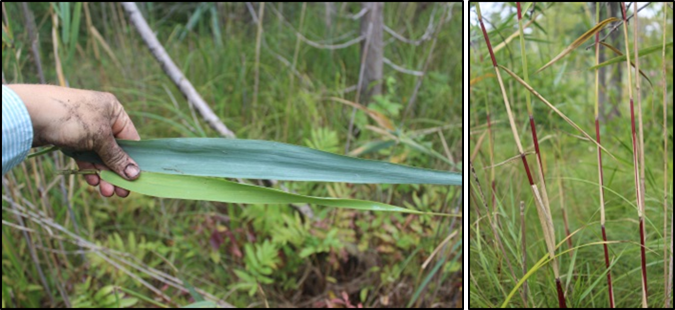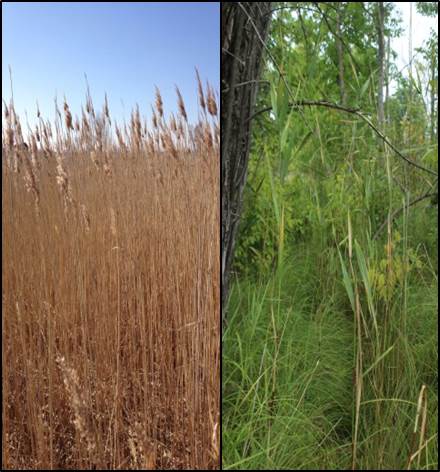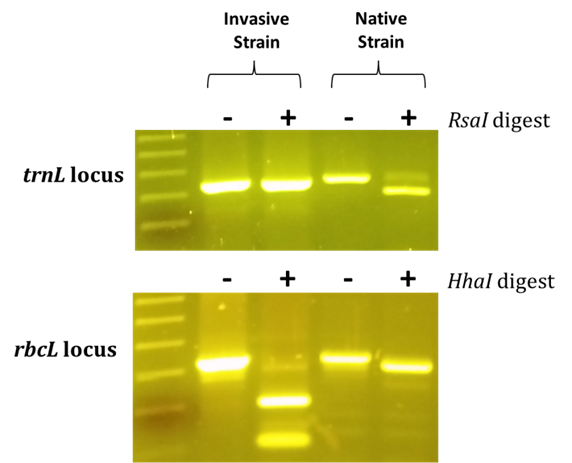July 13, 2015
Kimberly Bourke, U.S. Geological Survey, Contractor
Wesley Bickford, U.S. Geological Survey, Pathways Trainee, PhD student at University of Michigan
Although non-native Phragmites australis reigns supreme in terms of publicity, it is important remember that we also have stands of native Phragmites throughout the Great Lakes region. It can be difficult to distinguish between the native and invasive haplotypes while in the field, but many resources exist to help people identify which one they are dealing with. Distinguishing native from non-native Phragmites is important since focusing control efforts on the native haplotype can waste materials, person hours, and money, and result in unnecessary spraying of herbicides into the environment.
Where Is Native Phragmites Found?
According to the University of Michigan herbarium records, native Phragmites has been documented in 30 out of the 83 Michigan counties. Many of these records are decades old, so its current extent is less well understood. Through a brief and informal survey of land managers and some on-the-ground scouting, USGS and partners have identified five additional patches in southeast Michigan. Our search was in no way comprehensive, but our findings indicate that native Phragmites is much more common than we had initially anticipated. At some of these sites, non-native Phragmites was also present and, in some cases, growing right alongside the native haplotype. These findings raise some very interesting scientific questions, but also heighten the concern of accidental treatment of native Phragmites when targeting non-native Phragmites.
Tips to help tell them apart
The following are few quick pointers to help distinguish between the two while in the field:
Color: Side by side, the leaves of the invasive appear bluish, while native leaves are more yellow (this determination is difficult to make when you only have one haplotype at hand); live stems of invasive are dull green, whereas native stems frequently appear reddish or purplish.

The picture at left show leaves from invasive (top) and native (bottom) Phragmites australis plants. The picture on the right shows the red stems from native P. australis. Photo credits: Katherine Hollins
Leaf persistence: on dead non-native stems, leaf sheaths are difficult to remove, whereas on dead native stems, leaf sheaths are easily removed or fall off by themselves.
Ligule length: Non-native ligules are approximately half the length of native ligules (0.1-0.4 mm for invasive haplotype compared to 0.4-1.0 mm for native).
Density: Stands of non-native Phragmites are typically very large, tall, and dense (i.e. hard to walk through easily) while native stands are usually integrated with a more diverse plant community and not as dense.

The pictures above show different growth patterns of invasive and native Phragmites. The left side of the photo shows a very dense senesced growth of invasive Phragmites, as opposed to the picture at right which displays the sparse stems of native Phragmites growing alongside other wetland species. Photo credits: Wes Bickford and Katherine Hollins
There are many resources online and in print to help aid in distinguishing between the two haplotypes. Some great examples can be found at:
- Michigan Natural Features Inventory brochure- “Phragmites– Native or Not?”
- Great Lakes Phragmites Collaborative page – “Native vs. Invasive?”
- Wisconsin Wetlands Association – “Invasive Plant Profile – Phragmites“
- US Department of Agriculture “Common Reed Plant Guide”
- National Park Service and US Fish and Wildlife Service “Plant Invaders of Mid-Atlantic Natural Areas” – pages 25-26
- Michigan DEQ and partners, “A Guide to the Control and Management of Invasive Phragmites”
To confirm our morphological identification of the native plants we found during this fall’s field work, we sent leaf tissue to Dr. Doug Wendell at Oakland University. Doug analyzed DNA polymorphisms in both the native and non-native strains to further distinguish between the two using the methods of Saltonstall (2004).

The above graphic is of the resultant gel showing the DNA polymorphisms between invasive and native Phragmites. The invasive DNA is not cut by the RsaI digest, but is cut by the HhaI digest, whereas the native is cut by the RsaI digest, and not cut by the HhaI digest
If you need genetic confirmation for whether your Phragmites is native or invasive, then consider contacting one of the following cooperating laboratories:
- Oakland University, Rochester, MI
- Doug Wendell, Ph.D, wendell@oakland.edu
- Utah State University, Logan, UT
- Karen Mock, Ph.D, karen.mock@usu.edu
Native Phragmites is more prevalent in the Great Lakes than we previously assumed. It is frequently found in wetlands with high biodiversity and also supplies food and nesting resources for wetland residents. Care is needed before and during management of non-native Phragmites, so as to not spray and kill its native counterpart. It is possible that native Phragmites is present at the site you are managing, so be sure to take caution when applying management techniques.
